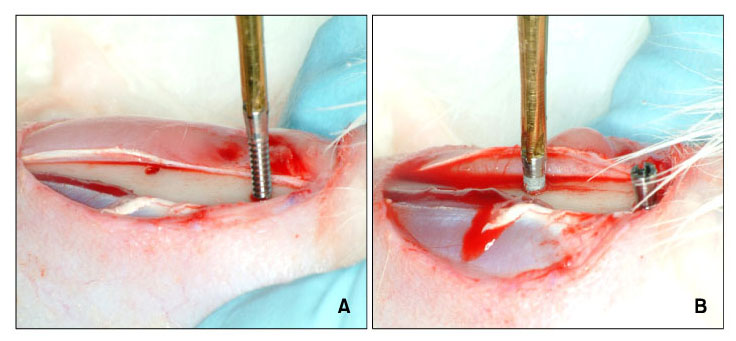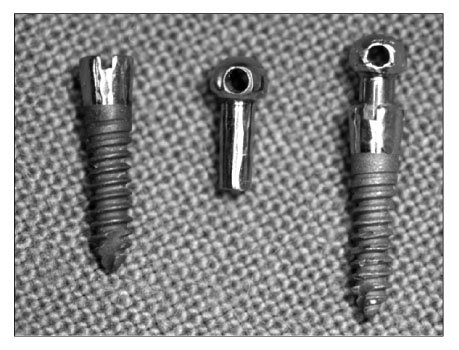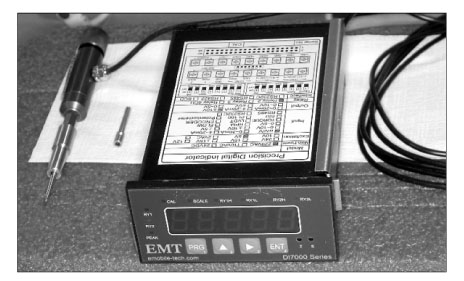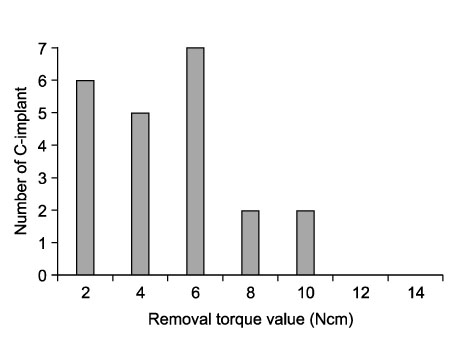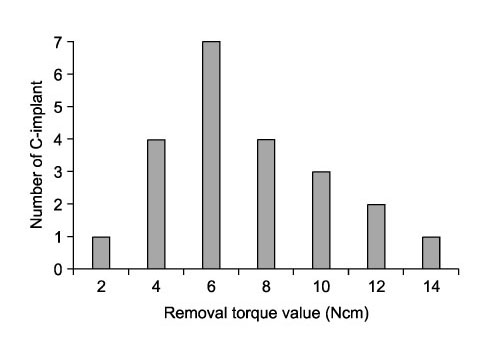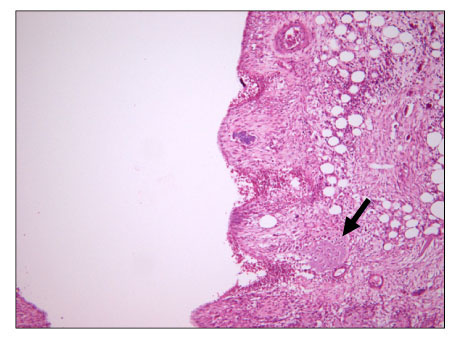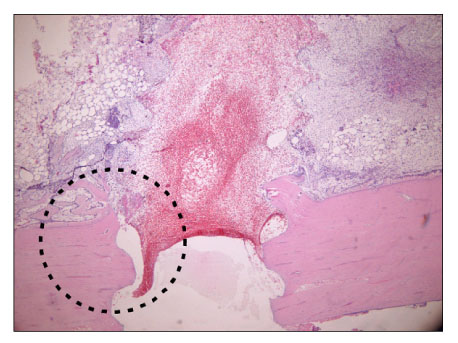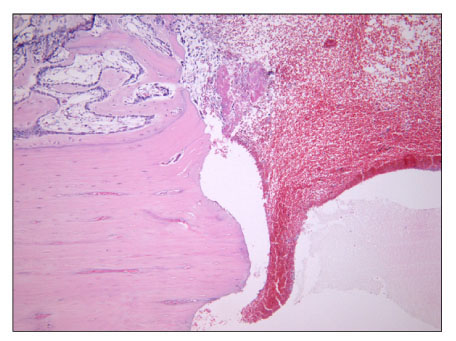Korean J Orthod.
2008 Oct;38(5):328-336. 10.4041/kjod.2008.38.5.328.
Effects of surface treatment on the osseointegration potential of orthodontic mini-implant
- Affiliations
-
- 1Graduate School of Clinical Dental Science, The Catholic University of Korea, Seoul, Korea.
- 2Division of Orthodontics, Department of Dentistry, The Catholic University of Korea, Seoul, Korea. bravortho@catholic.ac.kr
- KMID: 2273919
- DOI: http://doi.org/10.4041/kjod.2008.38.5.328
Abstract
OBJECTIVE
The purpose of this study was to compare the torque resistance to removal of sandblasted large grit and acid etched (SLA) surface treated orthodontic mini-implants and smooth surface orthodontic mini-implants as well as performing histologic observations.
METHODS
Two groups of custom screw shaped orthodontic mini-implants (C-implant, 1.8 mm outer diameter x 9.5 mm length, Cimplant, Seoul, Korea) were designated. 22 SLA treated C-implants (SLA group) and 22 machined surface C-implants (machined group) were placed in the tibia metaphysis of 11 adult New Zealand white rabbits. Following a 6-week healing period, the rabbits were sacrificed. Subsequently, the C-implants were removed under reverse torque rotation with a digital torque measuring device and independent t-test was performed. Selected tissues were prepared for histologic observation.
RESULTS
The SLA group presented a higher mean removal torque value (6.286 Ncm) than the machined group (4.491 Ncm) which was statistically significant (p < 0.005). Histologic observation revealed a trend of more new bone formation in contact with the screw surface in the SLA group than the smooth group.
CONCLUSIONS
The results of this study suggested that SLA surface treatment can enhance the osseintegration potential for C-orthodontic mini-implants.
Figure
Cited by 2 articles
-
The effects of different pilot-drilling methods on the mechanical stability of a mini-implant system at placement and removal: a preliminary study
Il-Sik Cho, HyeRan Choo, Seong-Kyun Kim, Yun-Seob Shin, Duck-Su Kim, Seong-Hun Kim, Kyu-Rhim Chung, John C. Huang
Korean J Orthod. 2011;41(5):354-360. doi: 10.4041/kjod.2011.41.5.354.Effect of surface anodization on stability of orthodontic microimplant
Sanket Karmarker, Wonjae Yu, Hee-Moon Kyung
Korean J Orthod. 2012;42(1):4-10. doi: 10.4041/kjod.2012.42.1.4.
Reference
-
1. Gainforth BL, Higley LB. A study of orthodontic anchorage possibilities in basal bone. Am J Orthod Oral Surg. 1945. 31:406–416.
Article2. Creekmore TD, Eklund MK. The possibility of skeletal anchorage. J Clin Orthod. 1983. 17:266–269.3. Kanomi R. Mini-implant for orthodontic anchorage. J Clin Orthod. 1997. 31:763–767.4. Costa A, Raffaini M, Melsen B. Miniscrew as orthodontic anchorage: a preliminary report. Int J Adult Orthodon Orthognath Surg. 1998. 13:201–209.5. Melsen B, Verna C. A rational approach to orthodontic anchorage. Prog Orthod. 1999. 1:10–22.
Article6. Park HS. A new protocol of the sliding mechanics with micro-implant anchorage (M.I.A). Korean J Orthod. 2000. 30:677–685.7. Park HS. Clinical study on success rate of micro screw implants for orthodontic anchorage. Korean J Orthod. 2003. 33:151–156.8. Klokkevold PR, Nishimura RD, Adachi M, Caputo A. Osseointegration enhanced by chemical etching of the titanium surface. A torque removal study in the rabbit. Clin Oral Implants Res. 1997. 8:442–447.
Article9. Buser D, Nydegger T, Hirt HP, Cochran DL, Nolte LP. Removal torque values of titanium implants in the maxilla of miniature pigs. Int J Oral Maxillofac Implants. 1998. 13:611–619.10. Cordioli G, Majzoub Z, Piatelli A, Scarano A. Removal torque and histomorphometric investigation of 4 different titanium surfaces: an experimental study in the rabbit tibia. Int J Oral Maxillofac Implants. 2000. 15:668–674.11. Klokkevold PR, Johnson P, Dadgostari S, Caputo A, Davies JE, Nishimura RD. Early endosseous integration enhanced by dual acid etching of titanium: a torque removal study in the rabbit. Clin Oral Implants Res. 2001. 12:350–357.
Article12. Lee SJ, Chung KR. The effect of early loading on the direct bone-to-implant surface contact of the orthodontic osseointegrated titanium implant. Korean J Orthod. 2001. 31:173–185.13. Cho SA, Jung SK. A removal torque of the laser-treated titanium implants in rabbit tibia. Biomaterials. 2003. 24:4859–4863.
Article14. Chung KR, Kim SH, Kook YA. The C-orthodontic micro-implant. J Clin Orthod. 2004. 38:478–486.15. Chung K, Kim SH, Kook Y. C-orthodontic microimplant for distalization of mandibular dentition in Class III correction. Angle Orthod. 2005. 75:119–128.16. Albrektsson T, Brånemark PI, Hansson HA, Lindström J. Osseointegration titanium implants. Requirements for ensuring a long-lasting, direct bone-to-bone implant anchorage in man. Acta Orthop Scand. 1981. 52:155–170.
Article17. Johansson C, Albrektsson T. Integration of screw implants in the rabbit: a 1-year follow-up of removal torque of titanium implants. Int J Oral Maxillofac Implants. 1987. 2:69–75.18. Ivanoff CJ, Sennerby L, Johansson C, Rangert B, Lekholm U. Influence of implant diameters on the integration of screw implant. An experimental study in rabbits. Int J Oral Maxillofac Surg. 1997. 26:141–148.19. Lim JW, Kim WS, Kim IK, Son CY, Byun HI. Three dimensional finite element method for stress distribution on the length and diameter of orthodontic miniscrew and cortical bone thickness. Korean J Orthod. 2003. 33:11–20.20. Cha JY, Yoon TM, Hwang CJ. Insertion and removal torques according to orthodontic mini-screw design. Korean J Orthod. 2008. 38:5–12.
Article21. Carlsson I, Röstlund T, Albreksson B, Albrektsson T. Removal torques for polished and rough titanium implants. Int J Oral Maxillofac Implants. 1988. 3:21–24.22. Darvell BW, Samman N, Luk WK, Clark RK, Tideman H. Contamination of titanium castings by aluminium oxide blasting. J Dent. 1995. 23:319–322.
Article23. Conchran DL, Nummikoski PV, Higginbottom FL, Hermann JS, Makins SR, Buser D. Evaluation of an endosseous titanium implant with sandblasted and acid-etched surface in the canine mandible: radiographic results. Clin Oral Implants Res. 1996. 7:240–252.24. Baker D, London RM, O'Neal R. Rate of pull-out strength gain of dual-etched titanium implants: a comparative study in rabbits. Int J Oral Maxillofac Implants. 1999. 14:722–728.25. Oh NH, Kim SH, Kook YA, Lee GH, Kang YG, Mo SS. Removal torque of sandblasted, large grit, acid etched treated mini-implant. Korean J Orthod. 2006. 36:324–330.26. Buser D, Schenk RK, Steinemann S, Fiorellini JP, Fox CH, Stich H. Influence of surface characteristics on bone integration of titanium implants. A histomorphometric study in miniature pigs. J Biomed Mater Res. 1991. 25:889–902.
Article27. Costa A, Dalstra M, Melsen B. L'Aarhus anchorage system. Ortognatodonzia Italiana. 2000. 9:487–496.
- Full Text Links
- Actions
-
Cited
- CITED
-
- Close
- Share
- Similar articles
-
- Bone cutting capacity and osseointegration of surface-treated orthodontic mini-implants
- Influence of surface treatment on the insertion pattern of self-drilling orthodontic mini-implants
- Three-dimensional finite element analysis for stress distribution on the diameter of orthodontic mini-implants and insertion angle to the bone surface
- Enhancement of bioactivity and osseointegration in Ti-6Al-4V orthodontic mini-screws coated with calcium phosphate on the TiO 2 nanotube layer
- The effect of early loading on the direct bone-to-implant surface contact of the orthodontic osseointegrated titanium implant

